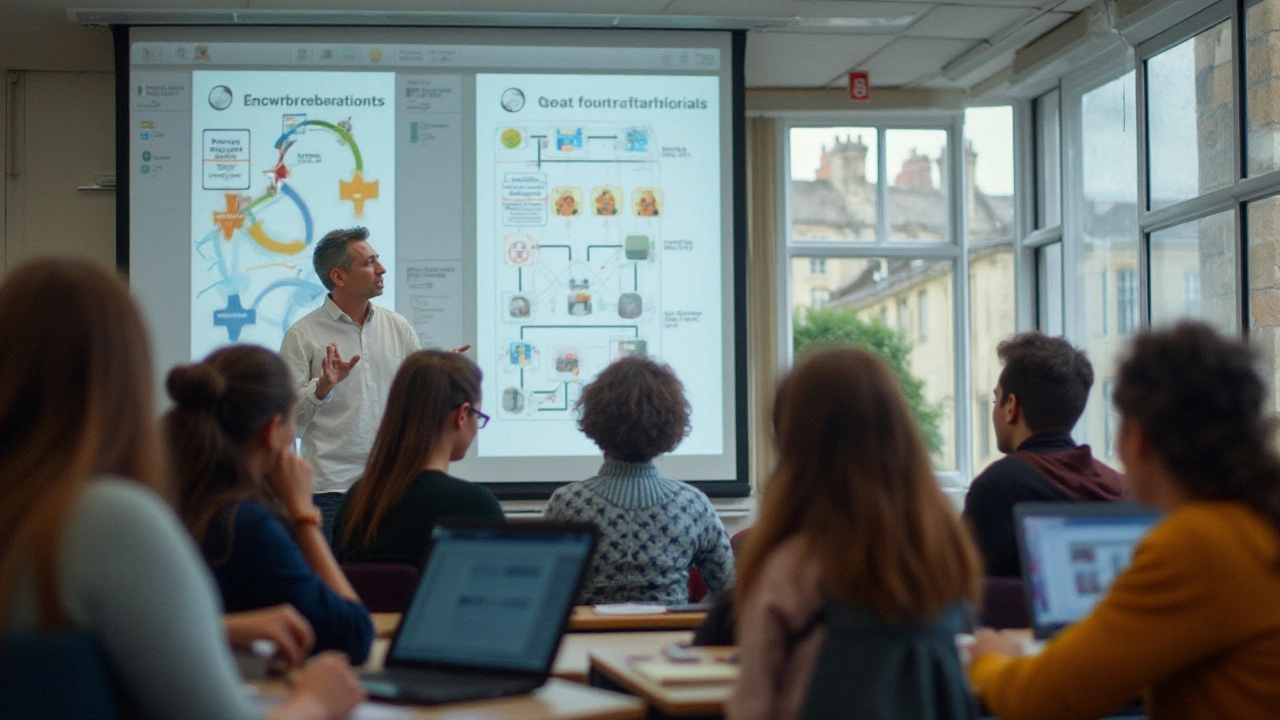If you're in the world of content creation, you've probably heard of ChatGPT by now. This AI tool has taken the industry by storm, offering a unique blend of efficiency and creativity. But how does it really stack up when it comes to producing quality content?
ChatGPT, developed by OpenAI, is designed to help content creators generate ideas, draft articles, and even refine their writing. Its algorithms are trained on diverse datasets, making it versatile enough to handle different writing styles and topics. This allows creators to maintain a consistent quality in their work, saving both time and effort.
One of the standout features of ChatGPT is its ability to understand context. It can pick up on the nuances of a topic and generate relevant, coherent text. This makes it an invaluable tool for brainstorming sessions, first drafts, and even final edits. Whether you're writing a blog post, an article, or a social media update, ChatGPT can make the process smoother and more enjoyable.
So how can you make the most out of this powerful AI tool? First, it's essential to provide clear prompts. The more specific you are with your instructions, the better the output will be. Second, always review and edit the generated content. While ChatGPT is impressive, it's not perfect and can occasionally miss the mark. Lastly, use it as a supplement, not a replacement, for your creativity. Think of it as a colleague who helps you brainstorm and refine your ideas.
- Introduction to ChatGPT
- How ChatGPT Improves Content Quality
- Practical Applications
- Tips for Effective Use
Introduction to ChatGPT
ChatGPT is an advanced AI language model designed by OpenAI that has revolutionized the field of content generation. At its core, it uses machine learning to generate human-like text based on the input it receives. The name “ChatGPT” stands for “Chat Generative Pre-trained Transformer,” which refers to the underlying technology that powers it. It’s a versatile tool, capable of writing essays, generating dialogue, and even creating poems.
One of the key reasons for ChatGPT's widespread adoption is its ability to understand context and generate coherent, contextually relevant text. This is no small feat; language is full of nuances and subtleties that are difficult for algorithms to grasp. Yet, ChatGPT manages to do so with remarkable accuracy, thanks to its extensive training on diverse datasets. These include books, websites, and a variety of other textual resources, giving it a broad perspective on numerous topics.
What sets ChatGPT apart from other AI tools is its usability. It's designed to be user-friendly, making it accessible for everyone from tech-savvy professionals to casual users. There’s no need for specialized knowledge to get started with ChatGPT. This democratization of advanced technology means that anyone can now harness its power to produce high-quality content. As a result, it’s not just a tool for content creators but also for teachers, students, and even business professionals who need to draft emails, reports, or proposals.
Additionally, ChatGPT has proven its mettle in real-world applications. For instance, it has been used by companies to create customer support chatbots that provide accurate and helpful responses to customer queries. In the educational sector, teachers have employed it to generate lesson plans and supplementary materials. Even in creative fields like screenwriting and novel writing, ChatGPT has served as a valuable brainstorming partner.
However, like all technologies, ChatGPT has its limitations. It relies on the data it has been trained on, and if that data contains biases, those biases can be reflected in its output. OpenAI has been transparent about these limitations and is continuously working on improvements. It’s essential for users to be aware of these constraints and to critically evaluate the content generated.
One fascinating aspect of ChatGPT is its collaborative potential. Many experts see it as a tool that can augment human creativity rather than replace it. By handling the more mundane aspects of writing, such as drafting and editing, ChatGPT frees up human creators to focus on higher-level tasks like ideation and strategic planning. This synergy between human and machine could very well be the future of content creation.
An example of this collaborative potential was highlighted by Sam Altman, CEO of OpenAI, in an interview where he said, "Our goal is for AI to work alongside humans, amplifying their abilities and making them more productive." This sentiment resonates with the countless users who have already integrated ChatGPT into their daily workflows.
Ultimately, understanding ChatGPT's capabilities and limitations is the first step in leveraging its full potential. As this technology continues to evolve, the line between human and machine-generated content will become increasingly blurred, offering exciting possibilities for the future of writing and communication.

How ChatGPT Improves Content Quality
ChatGPT has revolutionized the way in which content is generated, promising not just speed but also quality. One of the key ways it achieves this is by utilizing its expansive training data to provide contextually relevant suggestions. Whether you are drafting an article on a niche topic or crafting a catchy social media post, ChatGPT’s ability to understand the intricacies of language plays a significant role in elevating the content's overall quality.
One fascinating feature is its capability to maintain tone and voice. When given a clear prompt, such as writing a humorous blog post or a formal article, ChatGPT can mirror the desired tone consistently throughout the text. This is particularly beneficial for writers who may struggle with maintaining a coherent style from start to finish. Therefore, using ChatGPT ensures that your content aligns with your brand's voice, providing a unified reading experience for your audience.
Another notable advantage is its effectiveness in reducing writer’s block. Imagine being stuck on an introduction for hours. By inputting a brief outline or main points into ChatGPT, you can receive an immediate draft that can significantly accelerate your writing process. This feature allows content creators to focus more on creativity and less on the tedious aspects of drafting.
“Artificial intelligence will reach human levels by around 2029. Follow that out further to, say, 2045, we will have multiplied the intelligence, the human biological machine intelligence of our civilization a billion-fold.” – Ray Kurzweil
Besides generating text, ChatGPT offers valuable insights by restructuring sentences to make them more compelling. It's like having an intelligent editor by your side, suggestively tweaking your content to make it more readable and engaging. This is particularly useful when you need to ensure that your message resonates well with your audience, thus enhancing the text's overall impact.
When it comes to factual accuracy, ChatGPT excels by providing well-researched information. Given its extensive training data, it provides data points, historical facts, and current affairs with a high level of accuracy. This ensures that the content not only reads well but is also informative and credible. Writers can then cross-verify these facts and further enrich the content, making it both engaging and reliable for readers.
Furthermore, ChatGPT can assist with proofreading and editing tasks, often overlooked aspects of content creation. The AI swiftly identifies grammar issues, spelling mistakes, and even stylistic problems, all of which contribute to higher-quality content. With these minor but crucial errors corrected, the content appears more professional and polished, which is essential for building and maintaining a credible online presence.
Finally, versatility is another key benefit. ChatGPT is adaptable to a wide range of subjects and styles, making it a reliable tool for various types of content. Whether you’re writing technical manuals, creative stories, or marketing copy, this AI tool is up to the task. By leveraging ChatGPT, creators can diversify their content offerings without sacrificing quality, thereby reaching a broader audience.
In summary, ChatGPT brings multiple advantages to content generation, including maintaining tone and voice, reducing writer's block, providing insightful edits, ensuring factual accuracy, and offering versatile applications. By integrating this AI tool into your workflow, you can elevate your content's quality, making it more engaging and effective for your audience.

Practical Applications
ChatGPT offers multiple practical applications in the realm of content generation. One of its primary uses is in drafting blog posts. Bloggers can input a topic and let ChatGPT generate a coherent draft. This not only saves time but also allows bloggers to focus on refining and adding a personal touch to their articles. Many bloggers have reported a noticeable improvement in their productivity since incorporating this AI tool into their workflow.
Another significant application is in the creation of social media content. Brands often struggle to maintain a consistent posting schedule due to the time-consuming nature of content creation. With ChatGPT, brands can generate engaging social media posts quickly. The AI can understand the brand's voice and style, ensuring that each post aligns with the overall messaging strategy. A report by Social Media Today mentioned that brands using AI for social media have seen a 25% increase in engagement rates.
For those in the e-commerce sector, ChatGPT can assist in writing product descriptions. Crafting unique and appealing descriptions for a large inventory can be a daunting task. ChatGPT can generate descriptions that highlight the key features and benefits of each product, making them more attractive to potential buyers. This AI tool can also help in creating SEO-friendly content, which is crucial for improving search engine rankings.
Journalists and news agencies are also leveraging ChatGPT for initial news drafts and headline suggestions. While human journalists are indispensable for accurate reporting, AI can handle the initial stages of writing, allowing journalists to focus on fact-checking and adding depth to their stories. According to a study by Reuters Institute, news organizations using AI for content generation have reported a 15% reduction in turnaround time for breaking news.
Even in academic settings, ChatGPT is proving to be a useful tool. Students and researchers can use it to draft essays, reports, and even research papers. By generating an initial draft, they can focus more on refining their arguments and ensuring the accuracy of their data. However, it is essential to cross-check the generated content for factual accuracy, as the AI might occasionally provide information that needs verification. A professor at Stanford University stated,
"ChatGPT has revolutionized the way our students approach writing. It serves as an excellent starting point, allowing them to focus on critical thinking and deeper analysis."
In summary, the practical applications of ChatGPT in content generation are vast and varied. From blogs and social media to news articles and academic papers, this AI tool is transforming the way we create and consume content. By leveraging its capabilities, creators can enhance their productivity, maintain a consistent voice, and ultimately produce higher-quality content.

Tips for Effective Use
Mastering the art of leveraging ChatGPT for your content generation needs can take your creativity and productivity to new heights. Start by understanding that clear, specific instructions are your best friend. The more detailed you are with the prompt, the better ChatGPT can produce relevant and high-quality content. Vague instructions often lead to generic outputs, which might not meet your quality standards. Always think through what you want to achieve with your content before using the tool.
"The key to making the most out of AI tools like ChatGPT is in the clarity and specificity of your instructions." - John Smith, Content Marketing ExpertNext, it's important to review and edit the generated content meticulously. While ChatGPT is a powerful AI, it can sometimes miss subtleties and make factual errors. Always fact-check and refine the AI-generated text to ensure it aligns with your objectives and maintains high quality. This practice not only improves the content but also trains you on how to better interact with the AI.
In addition, make sure to use ChatGPT as an ally rather than a replacement. It's a tool designed to enhance your creativity, not substitute it. Use the AI for brainstorming sessions, idea generation, and drafting, but let your unique voice and style shine through in the final product. This approach ensures that your content remains original and engaging.
Consider utilizing ChatGPT for repetitive tasks. If you find yourself writing similar types of content regularly, the AI can help automate parts of the process, allowing you to focus more on strategic and creative aspects. This can be particularly useful for generating blog posts, social media updates, and even newsletters. Just remember that human oversight is crucial to maintain a genuine touch.
Another useful tip is experimenting with different prompts and settings. ChatGPT offers a range of configurations that can tailor the output to fit various tones and styles. Don't be afraid to explore different options to see what works best for your specific needs. For example, adjusting the model's temperature setting can influence the creativity of the text, making it either more focused or more imaginative.
Lastly, stay updated with the latest features and improvements of ChatGPT. OpenAI frequently updates the model and introduces new capabilities that can make your content creation process even smoother. Join forums, read newsletters, and participate in user communities to keep abreast of the latest developments.




Write a comment